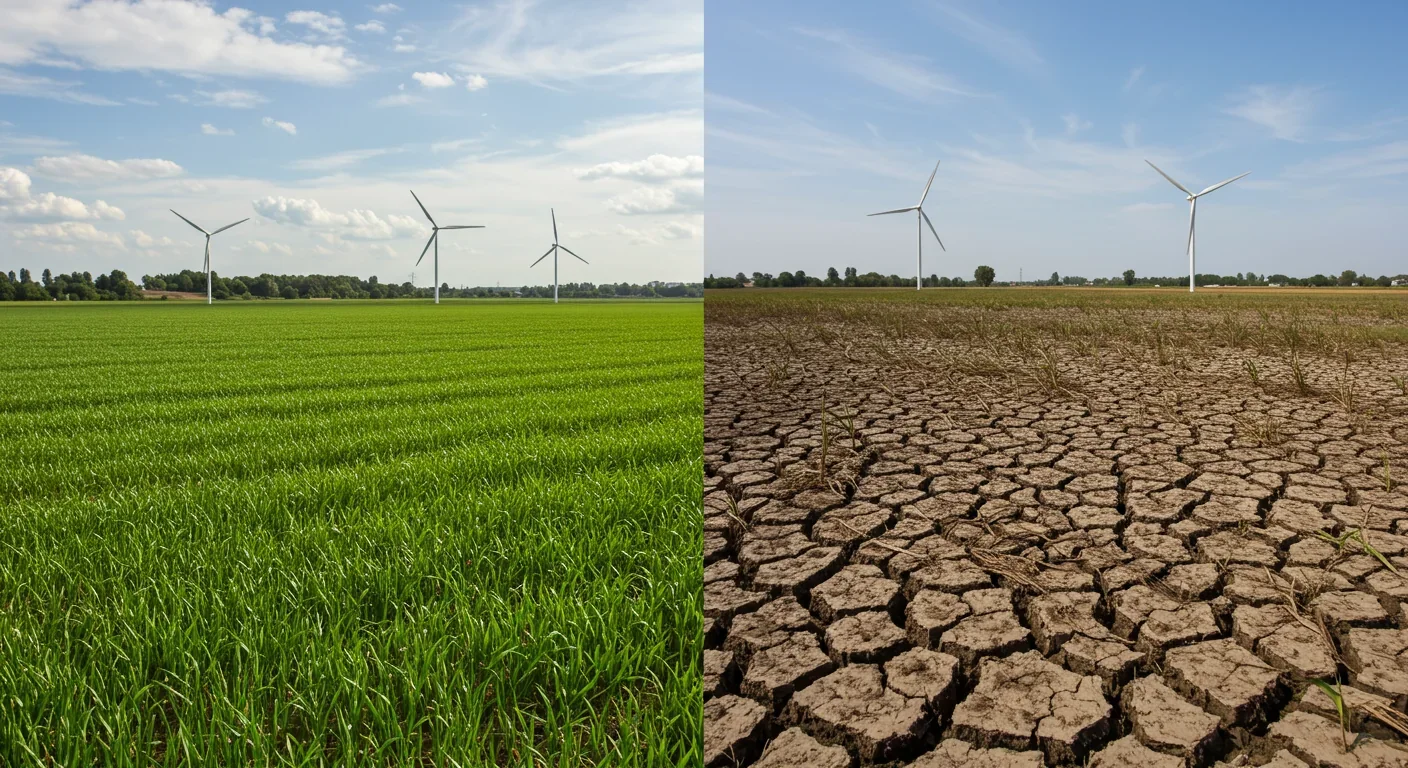Intercropping Boosts Farm Yields 20-50% While Building Resilience

TL;DR: Stratospheric aerosol injection could cool Earth by reflecting sunlight, but this controversial climate fix raises serious questions about ozone depletion, weather disruption, and who controls our planetary thermostat.

By 2030, we might witness the first large-scale deployment of technology that sounds like science fiction: aircraft spraying millions of tons of reflective particles into the upper atmosphere to cool the planet. Stratospheric aerosol injection (SAI) represents humanity's most ambitious—and contentious—backup plan for climate change. While some scientists see it as essential insurance against runaway warming, others warn it could trigger unintended catastrophes, from ozone depletion to geopolitical conflict. This technology forces us to confront an uncomfortable question: If we can't stop heating the planet the conventional way, should we hack the sky instead?
The concept behind SAI is surprisingly straightforward. Specialized aircraft or high-altitude balloons would release fine particles—typically sulfate aerosols—into the stratosphere, roughly 12 to 25 kilometers above Earth's surface. These particles would form a reflective haze that scatters incoming sunlight back into space before it can warm the surface.
Nature already proved this works. When Mount Pinatubo erupted in 1991, it injected about 17 million tons of sulfur dioxide into the stratosphere, creating a global sulfuric acid haze. Global temperatures dropped by 0.4 to 0.6°C for over a year, with solar radiation at the surface reduced by 10%. The eruption demonstrated that aerosol injection at stratospheric altitudes could produce measurable, planet-wide cooling.
SAI wouldn't need volcanic quantities of material to work. According to estimates, one kilogram of well-placed sulfur in the stratosphere would offset the warming effect of several hundred thousand kilograms of carbon dioxide. That extraordinary efficiency is what makes the technology both appealing and affordable, at least in financial terms.
The mechanics involve creating particles sized between 0.1 and 1 micrometer—small enough to remain suspended in the stratosphere for months or years, but large enough to effectively scatter sunlight. Researchers have explored various materials beyond sulfates, including calcium carbonate, titanium dioxide, and even diamond dust. Each comes with distinct optical properties, atmospheric chemistry impacts, and practical deployment challenges.
How much cooling could SAI actually deliver? The Intergovernmental Panel on Climate Change concludes that SAI is "the most-researched solar geoengineering method that could limit warming to below 1.5°C." Models suggest that deploying 5 million tons of aerosols annually at altitudes of 20 to 30 kilometers could offset much of the warming expected this century.
The projected timeline looks something like this: Initial small-scale tests could begin within five years, limited field experiments might run within a decade, and full deployment—if deemed necessary and politically feasible—could theoretically start by the 2030s. The cooling effects would appear within months of deployment, unlike carbon removal technologies that take decades to show results.
But SAI doesn't actually solve climate change. It's a painkiller, not a cure. The technology addresses only the temperature symptom while ignoring the underlying disease of excess atmospheric CO₂. Ocean acidification would continue unabated, harming marine ecosystems. And if SAI deployment suddenly stopped—a scenario called "termination shock"—temperatures could spike rapidly, potentially faster than ecosystems could adapt.
Recent research from University College London found that existing high-altitude aircraft could be modified to deliver aerosols, removing one major technical hurdle. The study calculated that a fleet of roughly 100 modified aircraft making continuous flights could maintain the necessary aerosol layer, at an annual cost far below previous estimates.
Here's where the science gets concerning. Stratospheric aerosols don't just reflect sunlight—they also interact with atmospheric chemistry in ways that can destroy ozone. The same Pinatubo eruption that demonstrated SAI's cooling potential also temporarily increased ozone depletion significantly.
Sulfate aerosols provide surfaces where chemical reactions convert stable chlorine compounds into ozone-destroying forms. In polar regions, where stratospheric clouds concentrate these aerosols, the effect intensifies. Modeling indicates that if high enough quantities of aerosols drift to polar stratospheric clouds before levels of CFCs and other ozone-destroying gases fall naturally, significant ozone depletion could occur.
The timing matters critically. We're still decades away from the ozone layer fully recovering from 20th-century CFC damage. Introducing large-scale SAI now could delay that recovery or even reverse progress. The health implications are serious: increased UV radiation reaching the surface would elevate skin cancer rates, harm crops, and damage marine phytoplankton that form the base of ocean food chains.
Scientists exploring alternative aerosol materials hope to sidestep the ozone problem. Calcium carbonate shows promise because it might actually help restore ozone rather than deplete it. But calcium carbonate particles are larger and heavier than sulfates, requiring more material and more frequent replenishment to achieve the same cooling effect.
Global average temperature is one thing; regional climate impacts are quite another. SAI wouldn't cool the planet uniformly, and the effects on precipitation patterns could reshape where and how people live.

Climate models project that SAI could reduce average rainfall in tropical regions while potentially increasing it at higher latitudes. For regions already struggling with water scarcity, this redistribution could prove catastrophic. Monsoon systems that billions depend on for agriculture might weaken or shift. The Indian summer monsoon, in particular, shows vulnerability to aerosol-induced changes in atmospheric circulation.
A recent regional case study examined how SAI might affect different parts of the world. The analysis found that while SAI could reduce temperature extremes globally, some regions would experience increased drought risk. The Atlantic hurricane region might see fewer storms, but the effect could shift tropical cyclone activity to different ocean basins with less prepared populations.
These regional disparities create a governance nightmare: Who decides what counts as acceptable climate outcomes? A technology that benefits one nation might harm its neighbors. What looks like salvation to a country facing deadly heat waves might look like agricultural devastation to a country dependent on stable rainfall patterns.
Unlike many geoengineering concepts that remain purely theoretical, SAI has reached the stage of proposed field experiments—though none have actually happened yet.
The Stratospheric Controlled Perturbation Experiment (SCoPEx), designed by Harvard researchers David Keith and Frank Keutsch, planned to release less than a kilogram of calcium carbonate into the stratosphere above Sweden. The experiment would have measured how the particles dispersed, how they interacted with atmospheric chemistry, and how they affected local radiation balance. Despite the minuscule scale—releasing less aerosol than a single commercial flight—the project faced intense opposition and was eventually suspended.
The UK's Stratospheric Particle Injection for Climate Engineering (SPICE) project met a similar fate. Researchers planned to test a high-altitude balloon system that could deliver aerosols to the stratosphere, but the field test was canceled in 2012 before any particles were released.
These cancellations reveal the political and ethical tensions surrounding even small-scale SAI research. Critics worry that field experiments normalize the technology, making full deployment seem inevitable. They argue that any outdoor testing crosses a moral line, moving geoengineering from computer models to physical reality. Proponents counter that we can't make informed decisions about SAI without real-world data that laboratory experiments and computer simulations can't provide.
Harvard's Solar Geoengineering Research Program continues investigating SAI through modeling and laboratory work, developing better understanding of aerosol physics and atmospheric chemistry. Their research tries to answer basic questions: What particle size works best? How long do different materials remain aloft? What's the optimal injection altitude?
One of SAI's most striking characteristics is how cheap it would be compared to other climate interventions. The annual cost of delivering 5 million tons of aerosol to stratospheric altitudes is estimated at $2 billion to $8 billion—an amount described as "sufficient to offset the expected warming during the next century."
To put that in perspective, $8 billion annually is less than many countries spend on their military budgets. It's a fraction of what renewable energy transitions cost. This affordability is both SAI's promise and its danger.
The low price tag means a single wealthy nation, or even a coalition of affected countries, could deploy SAI unilaterally without global consensus. A country facing existential climate threats doesn't need permission or international cooperation to cool the planet. This possibility keeps international relations experts awake at night.
But "cheap" is relative. While $2-8 billion might be affordable for wealthy nations, it's far beyond the resources of smaller, poorer countries that are often most vulnerable to climate change. This creates what researchers call a "technology divide"—those with resources could deploy SAI to serve their interests, while those without resources would simply experience the consequences.
The financial accessibility also raises uncomfortable questions about priorities. If we can cool the planet for $8 billion a year, why are we spending trillions on emission reductions? The answer, scientists emphasize, is that SAI addresses only temperature while leaving the root problem—excess CO₂—untouched. It's not an alternative to emission cuts; at best, it's a temporary supplement.

The governance challenge surrounding SAI has no precedent. No international law currently regulates stratospheric interventions. No treaty establishes who has authority to deploy planet-altering technology. No framework exists for determining acceptable risk levels or compensating those harmed by unintended consequences.
Current international environmental agreements weren't designed for geoengineering. The UN Convention on Biological Diversity issued a non-binding recommendation in 2010 urging governments to prevent geoengineering activities until risks are properly understood and governance frameworks exist. But recommendations aren't regulations, and they certainly can't stop a determined nation from acting unilaterally.
Recent UN sessions on solar geoengineering have triggered unease precisely because they highlight these governance gaps. Some delegations push for moratoriums on outdoor experiments. Others argue that research itself is essential for informed decision-making. A few nations, particularly those facing immediate climate threats like sea-level rise, openly consider SAI deployment regardless of international consensus.
Legal scholars exploring "geoengineering wars and atmospheric governance" warn that unilateral deployment could trigger military conflicts. If Country A deploys SAI and Country B experiences drought it attributes to that deployment, what happens? Do existing laws of war apply? Can affected nations claim compensation? Could climate intervention become an act of aggression?
The ethical dimensions are equally thorny. Who has the right to modify Earth's climate system, which affects every living thing? How do we weigh risks to future generations against immediate climate threats? What constitutes informed consent when the entire planet is the experiment? These questions combine philosophy, law, science, and politics in ways that defy easy answers.
One persistent concern about SAI research is "moral hazard"—the worry that knowing a technological fix exists will reduce motivation to cut emissions. If we can cool the planet with aerosols, why bother with the difficult political and economic work of decarbonization?
Recent research challenges this assumption. A Cambridge University study found that balanced messaging about solar geoengineering doesn't reduce average support for emissions reductions. People seem capable of understanding that SAI and emission cuts address different aspects of the climate problem—temperature versus atmospheric composition.
Public attitudes toward SAI vary dramatically by region and framing. In countries already experiencing severe climate impacts, support for researching SAI tends to be higher. In nations more focused on long-term sustainability, opposition is stronger. Framing matters too: describing SAI as "climate emergency intervention" generates different reactions than calling it "atmospheric engineering" or "sky modification."
What's striking in public opinion research is how little most people know about SAI. Despite decades of scientific research, geoengineering remains largely absent from mainstream climate discussions. This knowledge gap creates problems: Without informed public dialogue, decisions about potentially deploying SAI might get made by small groups of scientists and policymakers without broad societal input.
Education campaigns face their own dilemmas. Simply raising awareness about SAI could be interpreted as advocating for it. Explaining the technology requires discussing scenarios where it might be necessary, which some see as normalizing what should remain unthinkable.
SAI sits within a broader landscape of proposed climate interventions, each with distinct characteristics, costs, and risks.
Carbon dioxide removal technologies—like direct air capture, ocean fertilization, or enhanced rock weathering—address the root cause of climate change but work slowly and cost far more. Estimates suggest removing enough CO₂ to significantly affect temperature could cost hundreds of billions to trillions annually and take decades to show results.
Marine cloud brightening, which would spray seawater into low-altitude clouds to make them more reflective, offers regional cooling without stratospheric intervention. But it requires continuous operation near ocean surfaces, making it more vulnerable to disruption and less globally effective than SAI.
Space-based reflectors—giant mirrors or sunshades positioned between Earth and the Sun—sound elegant but face prohibitive costs and technical challenges. Launch expenses alone would dwarf SAI costs, and no current technology could manufacture and position the necessary structures.
SAI's unique combination of high effectiveness, low cost, and rapid response time makes it particularly attractive as emergency intervention. That's exactly what worries critics. The technology's appeal might seduce policymakers into viewing it as a substitute for emission reductions rather than a desperate last resort.
The U.S. Environmental Protection Agency emphasizes that no geoengineering approach should distract from the priority of reducing greenhouse gas emissions. SAI might buy time, but it doesn't buy solutions.
Despite the absence of field experiments, SAI research continues advancing through laboratory work, improved climate modeling, and analysis of natural volcanic aerosol events.
Recent modeling work used spatially-varying changepoint detection to trace Mount Pinatubo's global climate impacts with unprecedented precision. Researchers found that the eruption's cooling effect varied more by region and over time than previous analyses suggested, with implications for predicting SAI's spatial and temporal patterns.
Laboratory experiments are revealing new details about aerosol particle behavior. How quickly do different particles coagulate into larger sizes that fall from the stratosphere faster? How do particles interact with stratospheric water vapor, ozone, and other chemical species? These seemingly technical questions determine how well SAI would actually work and what side effects might emerge.
Computer models are growing sophisticated enough to simulate regional SAI effects. Instead of asking whether SAI would cool the planet (it would), researchers now ask: By how much in different regions? What would happen to African monsoons? How would Arctic ice respond? Would SAI affect El Niño patterns?
Growing scientific skepticism about geoengineering's promises reflects both improved understanding of complexity and recognition of governance challenges. The more researchers learn, the more they appreciate uncertainties and potential unintended consequences.
We're approaching a fork in the road. Climate change is accelerating, with global temperatures already more than 1.2°C above pre-industrial levels and headed higher. Ice sheets are melting faster than expected. Extreme weather events are intensifying. Ecosystems are shifting or collapsing.
If emission cuts prove insufficient to prevent catastrophic warming—and current trends suggest they might—someone will eventually propose deploying SAI. That decision point could arrive within 10 to 20 years, maybe sooner if a climate-triggered disaster galvanizes political will.
Preparing for that moment requires research that hasn't happened yet. We need better understanding of SAI's risks and benefits. We need governance frameworks that don't exist. We need public dialogue that's barely begun. We need to develop monitoring systems to detect whether deployed SAI is performing as intended or triggering unforeseen problems.
The tragedy is that we might need this technology precisely because we failed to act earlier. Every year of delayed emission reductions makes future climate scenarios worse, increasing the likelihood that SAI shifts from unthinkable to unavoidable.
As SAI moves from scientific abstraction to potential reality, several capabilities become increasingly valuable:
Climate literacy: Understanding basic climate science helps evaluate SAI claims and counterclaims. The technology can't be assessed without grasping what it does and doesn't address.
Systems thinking: SAI connects atmospheric chemistry, climate dynamics, international law, ethics, economics, and geopolitics. No single discipline captures the full picture. The ability to recognize connections across domains becomes essential.
Risk assessment: SAI presents novel risks—some known, others unknown. Developing comfort with uncertainty and probabilistic thinking helps navigate choices where all options involve trade-offs.
Governance awareness: Decisions about SAI will be made through political processes, not scientific consensus alone. Understanding how international agreements form, how public opinion shapes policy, and where power resides in climate governance prepares people to participate meaningfully.
Ethical reasoning: SAI raises profound questions about humanity's relationship with nature, our obligations to future generations, and how we make decisions affecting all life on Earth. Wrestling with these questions without easy answers is part of living in the Anthropocene.
Previous generations lived in a world where Earth's climate system was beyond human control—something that happened to us, not something we could fundamentally alter. That world is gone. We've already modified the climate through greenhouse gas emissions. The question isn't whether humans will shape Earth's climate, but how we'll do it and who gets to decide.
SAI represents the next potential step in that transformation—from inadvertent climate modification through emissions to deliberate climate intervention through atmospheric engineering. The technology forces uncomfortable recognition that we might need to actively manage Earth's climate system indefinitely.
There's no going back to a hands-off relationship with the climate. The carbon we've already emitted will affect the atmosphere for centuries. Even with aggressive emission cuts, Earth's climate will differ from the pre-industrial baseline. We're already living in a managed planet; we're just managing it poorly.
The real choice isn't between pristine nature and technological intervention. It's between different types and degrees of intervention, made with varying levels of foresight, equity, and wisdom. SAI is one option in that landscape—powerful, risky, and possibly necessary if we can't stabilize the climate through emission reductions and carbon removal alone.
Understanding SAI means confronting hard truths about the climate crisis and humanity's capacity for both innovative solutions and catastrophic mistakes. This technology will be available whether we use it or not. What we do with that capability will define the climate our children and grandchildren inhabit.
The stratosphere isn't just a physical boundary anymore. It's becoming a frontier where science, politics, ethics, and our collective future intersect. How we navigate that frontier will reveal what kind of planetary stewards we're capable of being.

Curiosity rover detects mysterious methane spikes on Mars that vanish within hours, defying atmospheric models. Scientists debate whether the source is hidden microbial life or geological processes, while new research reveals UV-activated dust rapidly destroys the gas.

CMA is a selective cellular cleanup system that targets damaged proteins for degradation. As we age, CMA declines—leading to toxic protein accumulation and neurodegeneration. Scientists are developing therapies to restore CMA function and potentially prevent brain diseases.

Intercropping boosts farm yields by 20-50% by growing multiple crops together, using complementary resource use, nitrogen fixation, and pest suppression to build resilience against climate shocks while reducing costs.

The Baader-Meinhof phenomenon explains why newly learned information suddenly seems everywhere. This frequency illusion results from selective attention and confirmation bias—adaptive evolutionary mechanisms now amplified by social media algorithms.

Plants and soil microbes form powerful partnerships that can clean contaminated soil at a fraction of traditional costs. These phytoremediation networks use biological processes to extract, degrade, or stabilize toxic pollutants, offering a sustainable alternative to excavation for brownfields and agricultural land.

Renters pay mortgage-equivalent amounts but build zero wealth, creating a 40x wealth gap with homeowners. Institutional investors have transformed housing into a wealth extraction mechanism where working families transfer $720,000+ over 30 years while property owners accumulate equity and generational wealth.

AlphaGo revolutionized AI by defeating world champion Lee Sedol through reinforcement learning and neural networks. Its successor, AlphaGo Zero, learned purely through self-play, discovering strategies superior to millennia of human knowledge—opening new frontiers in AI applications across healthcare, robotics, and optimization.